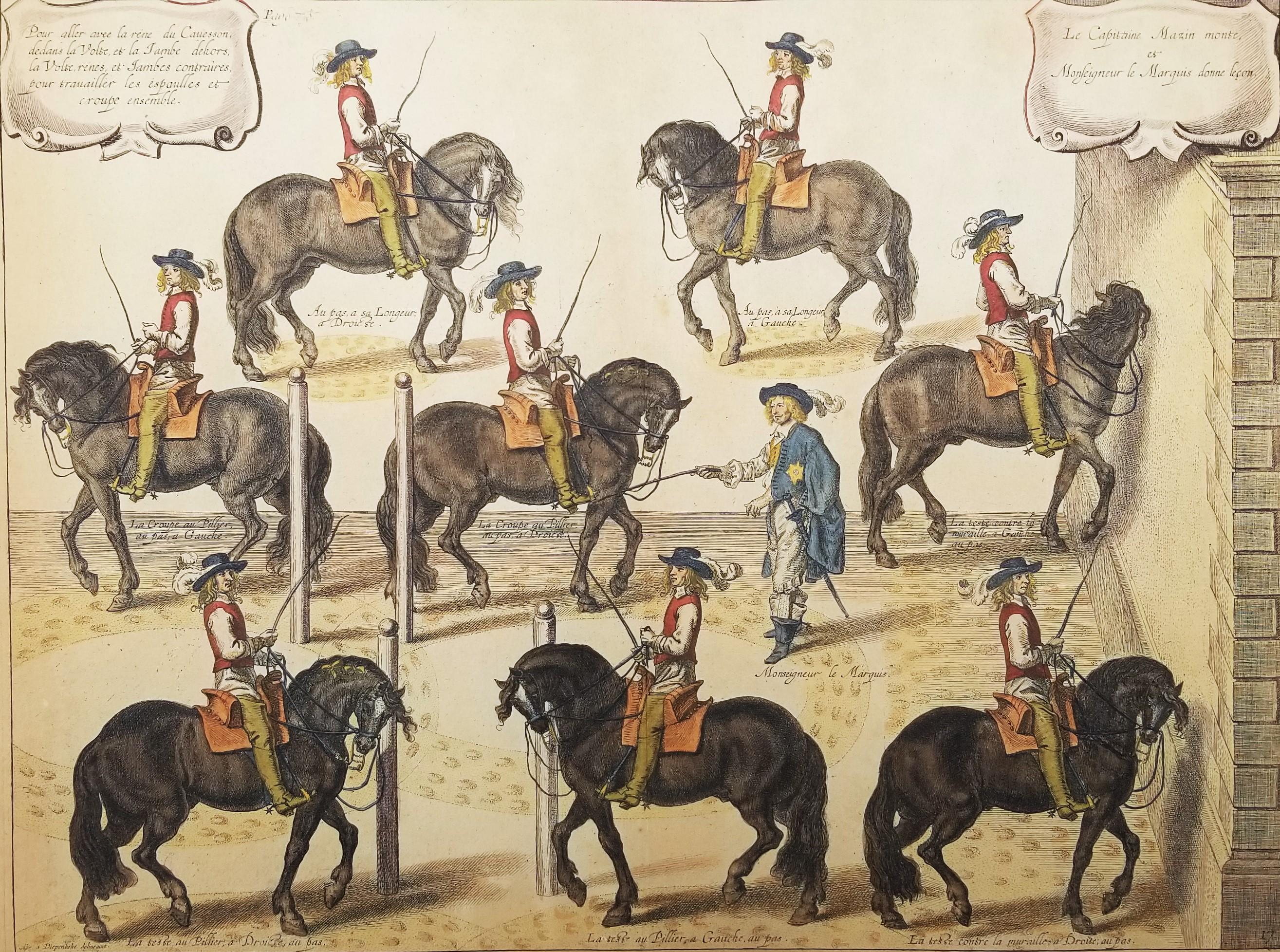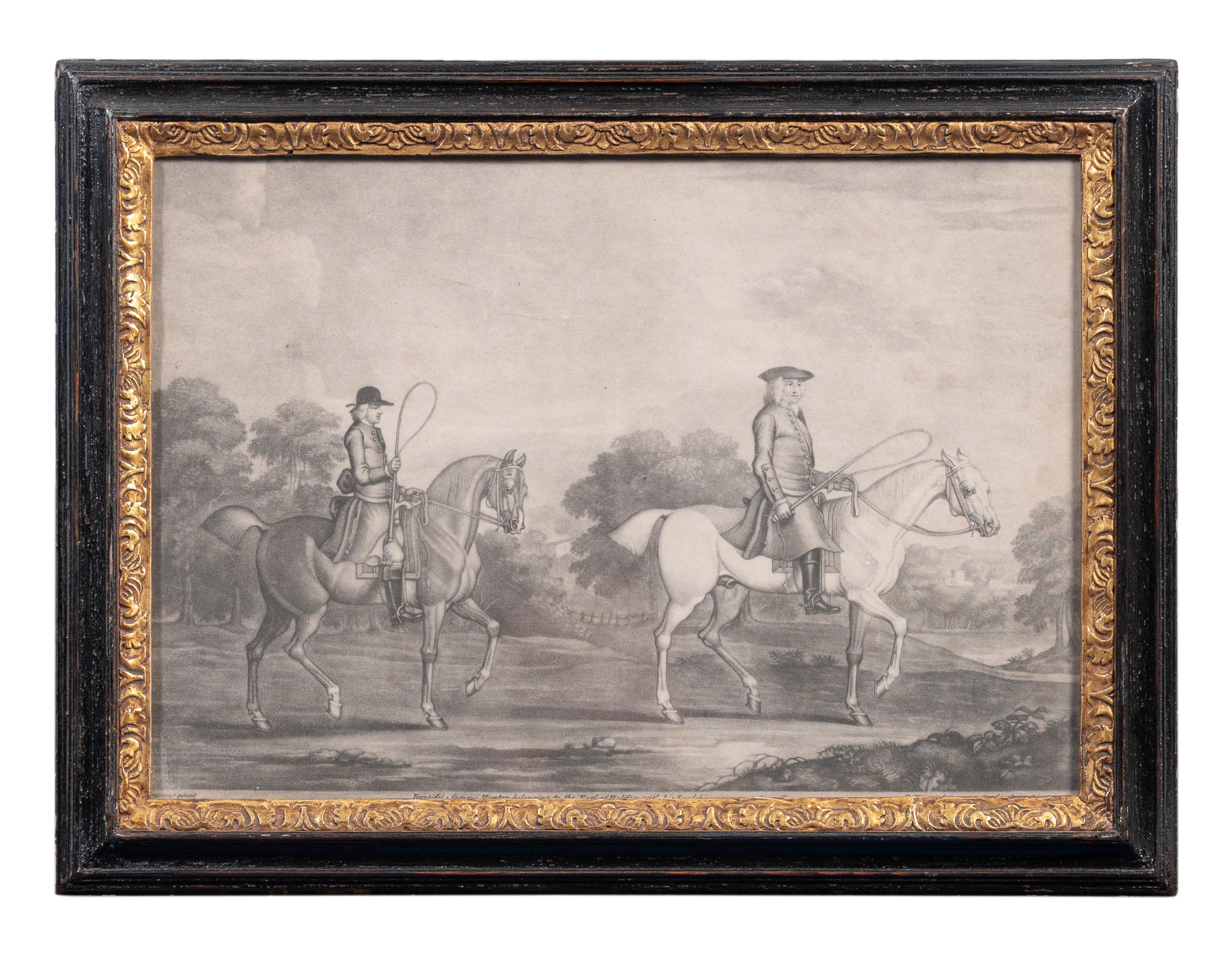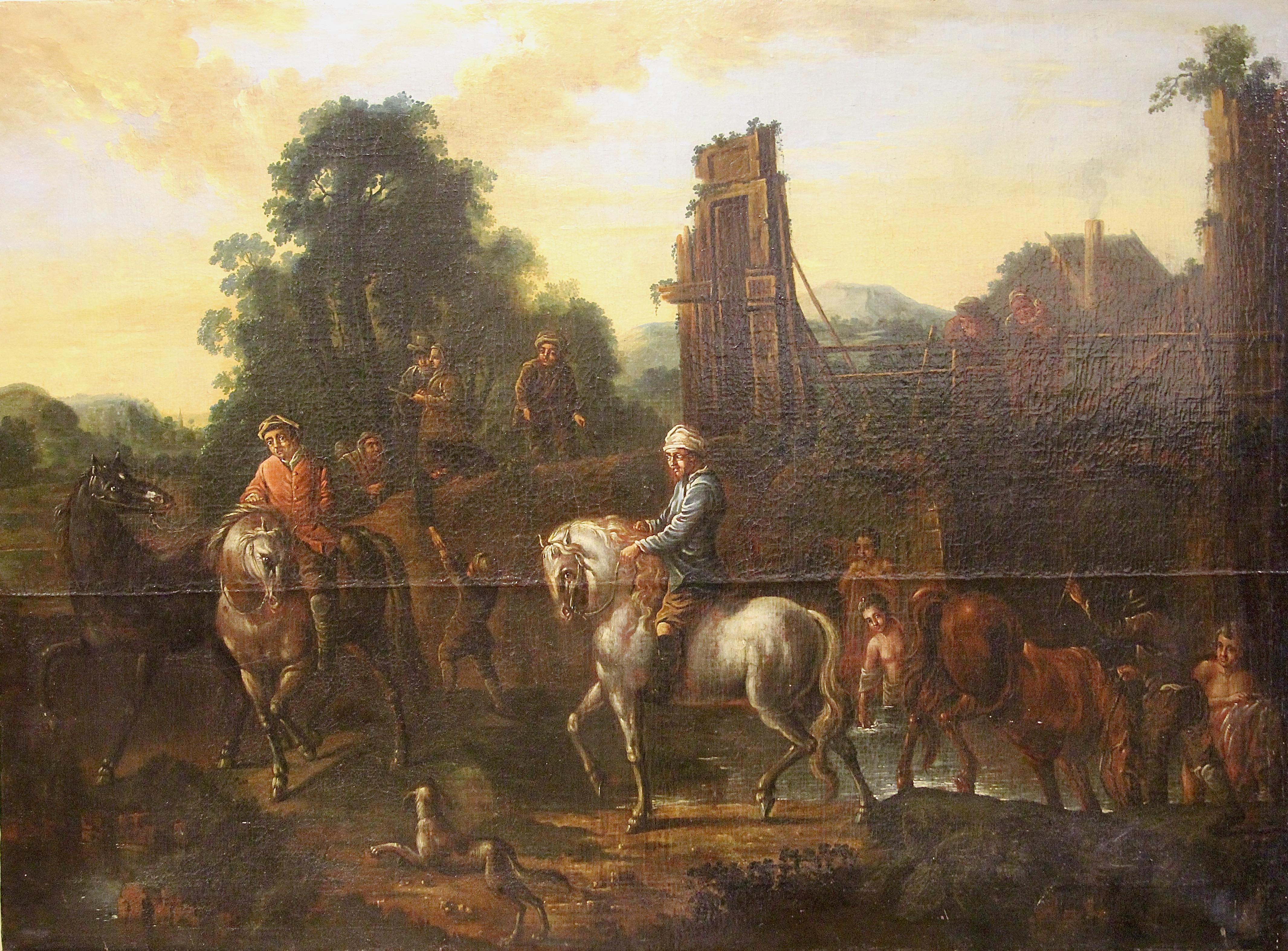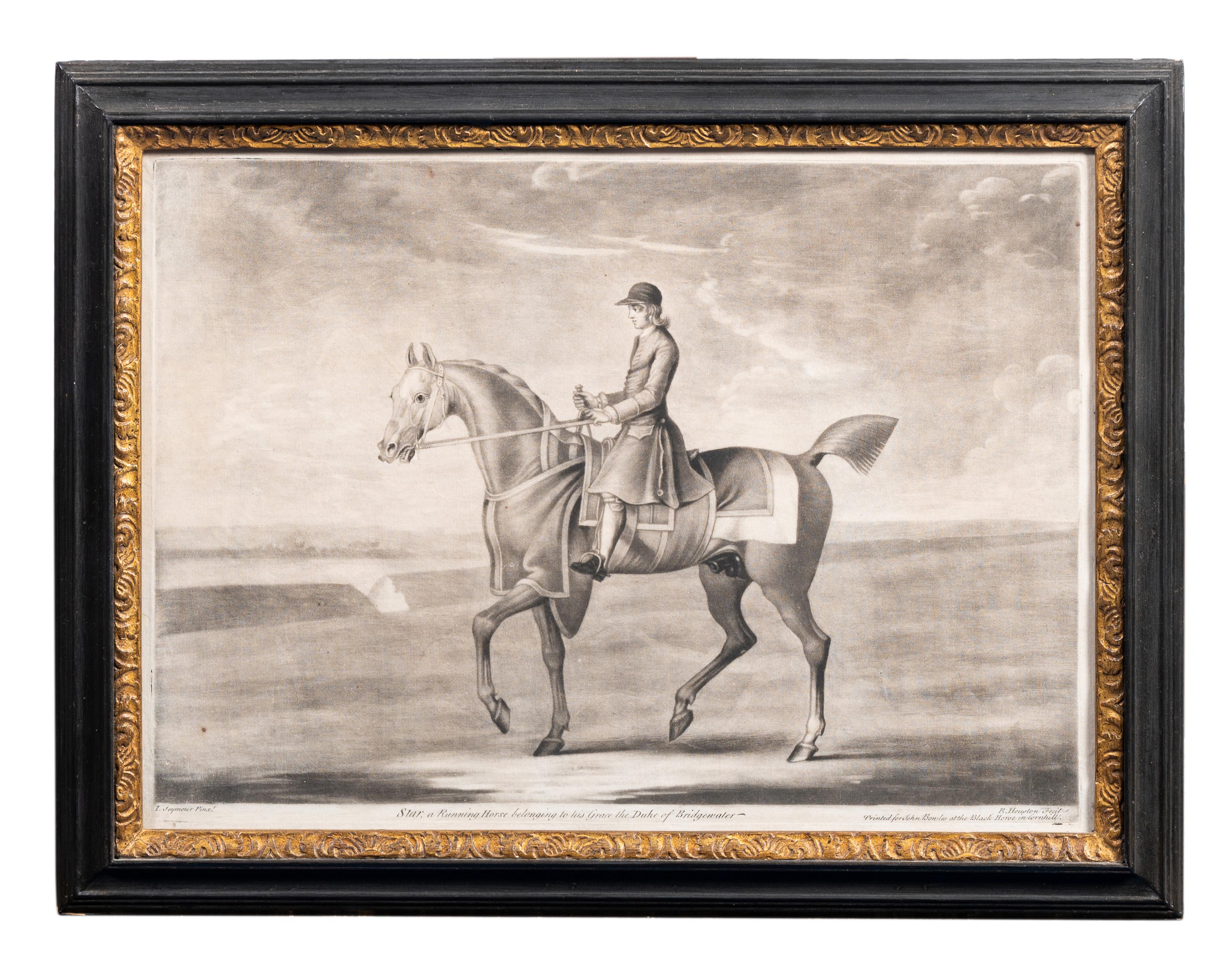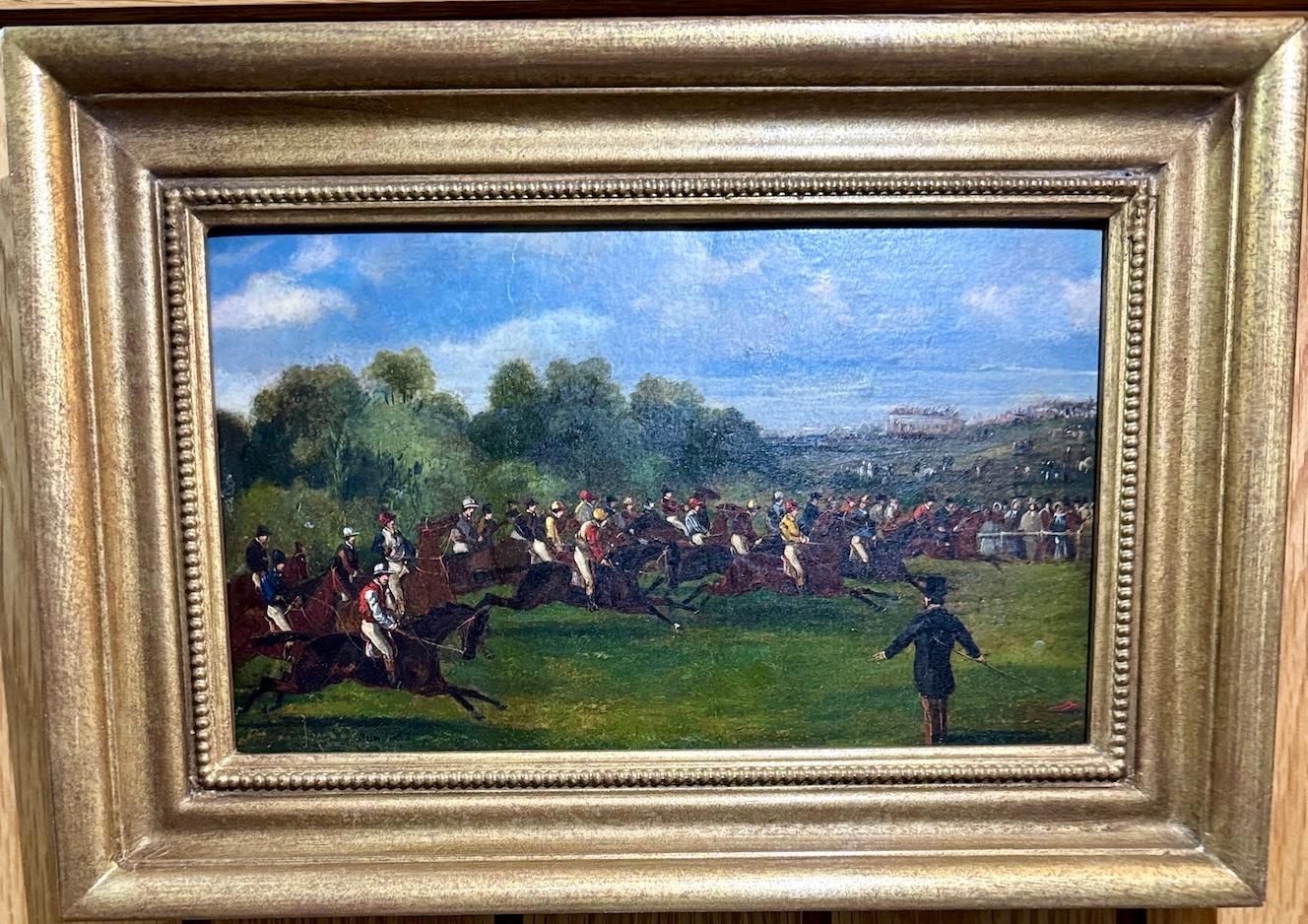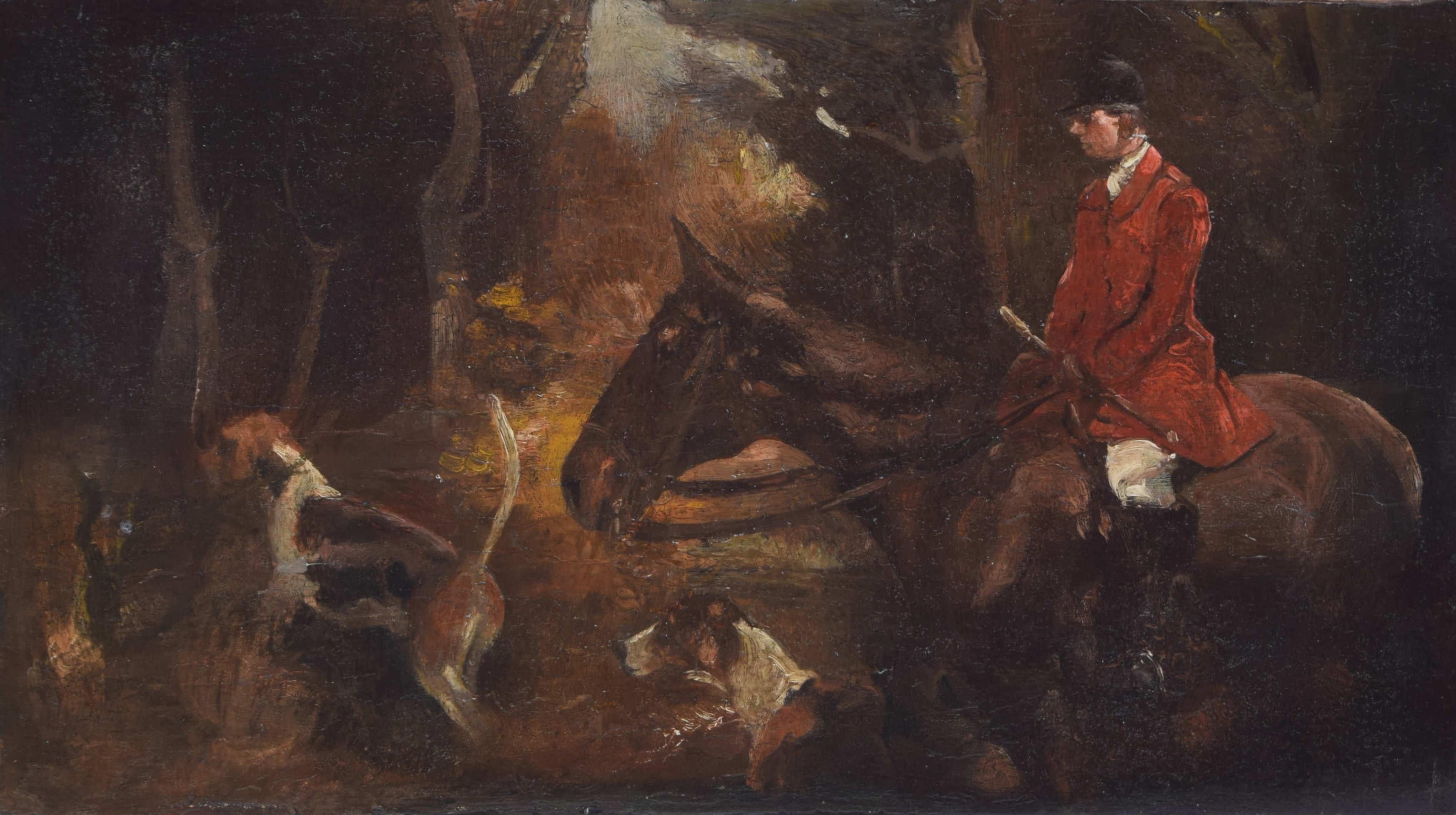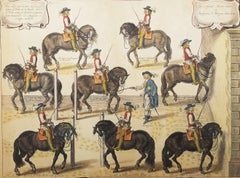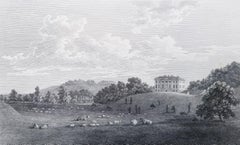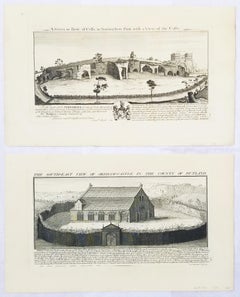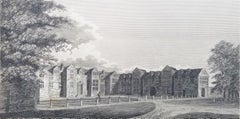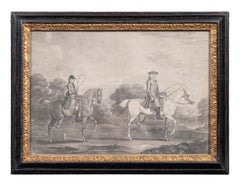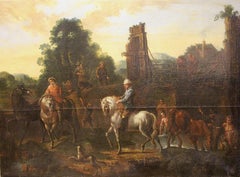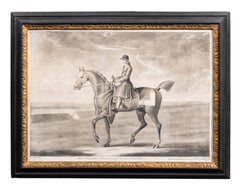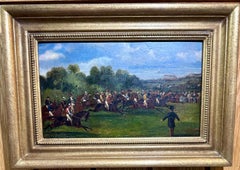Items Similar to Welbeck Park Belongs to the Marquis of Newcastle /// Equestrian Horse Old Master
Want more images or videos?
Request additional images or videos from the seller
1 of 21
William CavendishWelbeck Park Belongs to the Marquis of Newcastle /// Equestrian Horse Old Master1737
1737
$1,200
£904.92
€1,046.58
CA$1,683.59
A$1,871.42
CHF 980.96
MX$22,854.55
NOK 12,246.69
SEK 11,521.85
DKK 7,811.39
About the Item
Artist: William Cavendish (English, 1593-1676)
Title: "Welbeck Park Belongs to the Marquis of Newcastle" (Plate 38, Page 263)
Portfolio: Methode et Invention Nouvelle de Dresser Les Chevaux (New Method and Invention of Dressing Horses)
Year: 1737 (Second edition)
Medium: Original Hand-Colored Engraving and Etching on watermarked laid paper
Limited edition: Unknown
Printer: Jean Brindley, London, UK
Publisher: Jean Brindley, London, UK
Reference: Brunet I, 1699; Graesse II:93; Lowndes VI:1663; Mellon/Podeschi 26, page 34-35; Mennessier de la Lance II, page 246-247; Nissen ZBI 848; Huth page 21
Sheet size: 17" x 21.25"
Image size: 15" x 20"
Condition: Toning to sheet and some edgewear in right margins. Centerfold is separated at very top and bottom in margins. It is otherwise a strong impression in good condition with strong colors
Notes:
With overlapping centerfold as issued. Engraved by Dutch artist Theodor van Kessel (1620-1696) after a drawing by Dutch artist Abraham van Diepenbeeck (1596-1675). Comes from Cavendish's one volume "Methode et Invention Nouvelle de Dresser Les Chevaux", (1737) (Second edition), which consists of 42 double-paged engravings. Printed in one color from one copper plate: black. There is an unidentified fleur-de-lis style watermark in the center of the left sheet.
The 1657-1658 (First edition) of "Methode et Invention Nouvelle de Dresser Les Chevaux" was printed and published by Jacques Van Meurs in Antwerp, Belgium in two issues, 1657 and 1658. It consists of 42 double-paged copperplate engravings executed by Dutch artists Pieter de Jode II or (the Younger) (1606-1674), Pieter Clouwet (1629-1670), Pieter van Lisebetten (1630-1678), Cornelis Van Caukercken (1626-1680), Lucas Vorsterman II (1624-c.1666), Adriaen Lommelin (1620-1673), and Theodor van Kessel (1620-1696) after drawings by Dutch artist Abraham van Diepenbeeck (1596-1675). "This first printing was largely destroyed by fire in the bookseller’s shop, and is all but impossible to acquire." - Brunet. The 1737 (Second edition) of "Methode et Invention Nouvelle de Dresser Les Chevaux" was the first to be published in England using the same original 42 copperplates and 50 woodcut text diagrams from 1658, acquired by printer/publisher Jean Brindley in London, UK.
"The Duke of Newcastle, a staunch royalist went into exile to Antwerp in 1644. Newcastle had bought a pair of Barbary horses in Paris and set up a stable for training his horses. Translated from his manuscript in English, it illustrates the riding school which, in spite of the loss of a vast fortune in England during the Civil War, he managed to build up at Antwerp where he was residing as an exile from the Commonwealth. Although showered with honors by Charles II at the Restoration, he retired to his estates in Derbyshire and devoted himself to literature, the breeding of horses and equitation. His manége near Bolsover still exists. This work, partly paid for by his friend Sir Hugh Cartwright, is a celebration of Dukes' horses and their training. The plates include five equestrian portraits, four of the author; five plates of his own horses; and 24 scenes showing horses being trained (most featuring the Duke, Captain Mazin and occasionally, a groom named Palfrenier). There are also two allegorical designs, in which the Duke is adored by a circle of reverential horses, and at the end a portrait of the Cavendish family." - Christie's, New York
Biography:
William Cavendish, 1st Duke of Newcastle upon Tyne, KG, KB, PC (c. 16 December 1593 – 25 December 1676), who after 1665 styled himself as Prince William Cavendish, was an English courtier and supporter of the arts. He was a renowned horse breeder, as well as being patron of the playwright Ben Jonson and the intellectual group known as the Welbeck Circle. Despite spending the then enormous sum of £15,000 entertaining Charles I in 1634, he failed to gain a significant political post. In the early stages of the First English Civil War, he was appointed Royalist Captain-General in Northern England; he financed much of the war effort himself, later claiming this totaled in excess of £1,000,000. After the defeat at Marston Moor in July 1644, a battle fought against his advice, he went into exile in Europe. He returned to England after the Stuart Restoration in 1660, and although created Duke of Newcastle in 1665, he remained on the fringes of the court and became critical of Charles II. He died in 1676 and was buried in Westminster Abbey.
- Creator:William Cavendish (1593 - 1676, English)
- Creation Year:1737
- Dimensions:Height: 17 in (43.18 cm)Width: 21.25 in (53.98 cm)
- Medium:
- Movement & Style:
- Period:1730-1739
- Condition:
- Gallery Location:Saint Augustine, FL
- Reference Number:1stDibs: LU12126068442
About the Seller
5.0
Platinum Seller
Premium sellers with a 4.7+ rating and 24-hour response times
Established in 1978
1stDibs seller since 2015
1,342 sales on 1stDibs
Typical response time: <1 hour
- ShippingRetrieving quote...Shipping from: Saint Augustine, FL
- Return Policy
Authenticity Guarantee
In the unlikely event there’s an issue with an item’s authenticity, contact us within 1 year for a full refund. DetailsMoney-Back Guarantee
If your item is not as described, is damaged in transit, or does not arrive, contact us within 7 days for a full refund. Details24-Hour Cancellation
You have a 24-hour grace period in which to reconsider your purchase, with no questions asked.Vetted Professional Sellers
Our world-class sellers must adhere to strict standards for service and quality, maintaining the integrity of our listings.Price-Match Guarantee
If you find that a seller listed the same item for a lower price elsewhere, we’ll match it.Trusted Global Delivery
Our best-in-class carrier network provides specialized shipping options worldwide, including custom delivery.More From This Seller
View AllCaptain Mazin Rides, and the Marquis Gives the Lesson /// Equestrian Horse Art
By William Cavendish
Located in Saint Augustine, FL
Artist: William Cavendish (English, 1593-1676)
Title: "Captain Mazin Rides, and the Marquis Gives the Lesson" (Plate 17, Page 76)
Portfolio: Methode et Invention Nouvelle de Dresser ...
Category
1730s Old Masters Animal Prints
Materials
Watercolor, Laid Paper, Engraving, Etching, Intaglio
Came, the Seat of the Hon. Lionel Damer /// Dorsetshire John Hutchins English
Located in Saint Augustine, FL
Artist: John Hutchins (English, 1698-1773)
Title: "Came, the Seat of the Hon. Lionel Damer" (Plate 48)
Portfolio: The History and Antiquities of the County of Dorset
Year: 1796-1815 ...
Category
1790s Old Masters Landscape Prints
Materials
Engraving
"Oakham Castle" and "Nottingham Park/Castle" from "Buck's Antiquities" /// UK
By Samuel & Nathaniel Buck
Located in Saint Augustine, FL
Artist: Samuel and Nathaniel Buck (English, 1696-1779) and (?-1759/1774)
Title: "Oakham Castle" (Plate 242) and "Nottingham Park/Castle" (Plate 226)
Portfolio: Buck's Antiquities or Venerable Remains of Above 400 Castles, Monasteries, Palaces in England and Wales
Year: 1726-1739
Medium: Set of Two Original Engravings on watermarked laid paper
Limited edition: Unknown
Printer: Unknown
Publisher: Robert Sayer, London, UK
Reference: Lowndes page 303-304; Upcott page 33
Sheet size (each): approx. 11" x 18.25"
Image size (platemark) (each): approx. 7.75" x 14.75"
Condition: "Nottingham Park" has light soiling in margins and scattered light foxmarks across sheet. They are both otherwise strong impressions in very good condition
Notes:
Comes from Samuel and Nathaniel Buck's three volume portfolio "Buck's Antiquities" or "Venerable Remains of Above 400 Castles, Monasteries, Palaces in England and Wales" (1726-1739), which consists of 428 engravings. Both "Oakham Castle" and "Nottingham Park/Castle" have unidentified watermarks in the center of their sheets. They both also have "Liverpool Free Public Library" chop mark/blind stamps at bottom center of their sheets. Old price pencil inscribed in margins.
Oakham Castle is a historic building in Oakham, Rutland. The castle is known for its collection of massive horseshoes and is also recognised as one of the best examples of domestic Norman architecture in England. It is a Grade I listed building. Owned and managed by the Rutland County Council, Oakham Castle is licensed for civil...
Category
1720s Old Masters Landscape Prints
Materials
Laid Paper, Engraving, Intaglio
Loseley House, The Seat of James More Molyneux Esq. /// English Landscape Surrey
Located in Saint Augustine, FL
Artist: Owen Manning (English, 1721-1801)
Title: "Loseley House, The Seat of James More Molyneux Esq."
Portfolio: The History and Antiquities of the County of Surrey
Year: 1804-1814 ...
Category
Early 1800s Victorian Landscape Prints
Materials
Engraving
Het leeuwendeel (The Lion's Share) /// Old Masters Animals Landscape Dog Leopard
By Dirk Stoop
Located in Saint Augustine, FL
Artist: Dirk Stoop (Dutch, c.1615-1686)
Title: "Het leeuwendeel (The Lion's Share)"
Portfolio: The Fables of Aesop
Year: 1665 (an earlier state of unknown states)
Medium: Original Et...
Category
1660s Old Masters Animal Prints
Materials
Etching, Laid Paper, Intaglio, Gesso
Set of Two Engravings from Nash's "History of Worcestershire" /// Landscapes Art
By Treadway Russell Nash
Located in Saint Augustine, FL
Artist: Treadway Russell Nash (English, 1724-1811)
Title: "Henbury Hall, late the Seat of Thomas Vernon, now of Henry Cecil Esq." and "Ombersley Court, the Seat of Lord Sandys"
Portfolio: Collections for the History of Worcestershire
Year: 1781-1782 (First edition)
Medium: Set of Two Original Engravings and Etching with Aquatint on watermarked laid paper
Limited edition: Unknown
Printer: John Nichols, London, UK
Publisher: T. Payne and Son, J. Robson, B. White, Leigh and Sotheby, London, UK; Fletcher, Oxford, UK; and Lewis, Worcester, UK
Reference: Upcott III, page 1330
Sheet size (each): approx. 10.13" x 16.88"
Image size (each): approx. 8.13" x 12.63"
Condition: "Henbury Hall, late the Seat of Thomas Vernon, now of Henry Cecil Esq." has scattered light foxmarks in margins. The top edge is unevenly trimmed and a small taped tear to lower right corner. "Ombersley Court, the Seat of Lord Sandys" has light toning to sheet and some faint discoloration in right margin. A small light water stain to lower left corner. Have been professionally stored away for decades. They are both otherwise strong impressions in good condition
Notes:
Provenance: private collection - Aspen, CO. "Henbury Hall, late the Seat of Thomas Vernon, now of Henry Cecil Esq." was likely engraved by English artist James Ross (1745-1821) after a drawing by himself. "Ombersley Court, the Seat of Lord Sandys" was engraved by English artist Valentine Green (1739-1813) and English artist Francis Jukes (1745-1812) after a drawing by an unknown, likely English artist. The first work is an engraving; the second work is an etching with aquatint. Comes from Nash's two volume "Collections for the History of Worcestershire", (1781-1782) (First edition), which consists of 75 engravings. Each work is printed from copper plates in one color: black. There was a (Second edition) "with Additions" bound in with Volume II of this portfolio published by John White in (1799). And both the First and Second editions of "Collections for the History of Worcestershire" are based off Thomas Sanders' 1779-1781 "Perspective Views of the Market Towns within the County of Worcester". "Ombersley Court, the Seat of Lord Sandys" has an unidentified watermark in the center of its sheet. "Henbury Hall" is actually incorrectly misnamed; its correct name is "Hanbury Hall".
"PLATES, Drawn and engraved by J. Ross, unless otherwise expressed." - "A Bibliographical Account of the Principal Works Relating to English Topography", (1818) - William Upcott.
Biography:
Treadway Russell Nash (24 June 1724 – 26 January 1811) was an English clergyman, now known as an early historian of Worcestershire and the author of Collections for the History of Worcestershire, an important source document for Worcestershire county histories. He was a fellow of the Society of Antiquaries of London.
Treadway Russell Nash was born on 24 June 1724 born at Clerkenleap, in Kempsey, Worcestershire. His family were from Ombersley. They had lands there and at Claines, and had later bought lands in the Reformation around St Peter's, Droitwich. He was related to James Nash and John Nash, both MPs for Worcester. His father Richard, a grandson of Sir Rowland Berkeley, died in 1740, and Richard's eldest son in 1757. As a result, Treadway Russell Nash inherited the Russells' Strensham estates from his brother, as well as the Nash estates, and took both names.
He was educated from the age of twelve at King's School, Worcester, and became a scholar at Worcester College, Oxford aged fifteen. In March 1749, he accompanied his brother on a trip to the continent, to aid Richard's health. They visited Paris for about six weeks, before spending the summer "on the banks of the Loire". They then visited "Bourdeaux, Thoulouse, Montpelier, Marseilles, Leghorn, Florence, Rome, Naples, Bologna, Venice, Padua, Verona, Milan, Lyons, and again Paris"; such expeditions are often known as the Grand Tour.
On his return in late summer 1751, Nash took up a post as Vicar of Eynsham through his friend and future brother-in-law, John Martin. He also had an income as a tutor at Oxford. He took his Doctor of Divinity degree and left Oxford, having "gone out grand compounder", following the death of his brother. He also left his benefice at Eynsham in 1757. While at Oxford he had proposed a road from there to Witney (now the A40 and B4022), and also stood for Parliament. Nash married Margaret Martin...
Category
1780s Old Masters Landscape Prints
Materials
Laid Paper, Engraving, Intaglio, Etching, Aquatint
You May Also Like
'Ironsides' a famous Hunter belonging to the Earl of Halifax
By James Seymour
Located in Stoke, Hampshire
James Seymour (1702-1752)
'Ironsides' a famous Hunter belonging to the Earl of Halifax
Mezzotint by R. Houston
Image size 9 1/4 x 13 1/4 in
Framed size 12 x 16 in
James Seymour was ...
Category
18th Century Old Masters Animal Paintings
Materials
Mezzotint
17th Century, Old Master Painting, Oil on Canvas, "The Rest with the Horses".
Located in Berlin, DE
17th century, old master painting, oil on canvas, "The rest with the horses".
Relined canvas.
The stretcher was also renewed once.
The painting is rather dark, like i.a. on photo n...
Category
17th Century Old Masters Figurative Paintings
Materials
Canvas, Oil
$17,177 Sale Price
50% Off
Free Shipping
'Star', A running horse belonging to His Grace the Duke of Bridgewater
By James Seymour
Located in Stoke, Hampshire
James Seymour (1702-1752)
'Star', A running horse belonging to His Grace the Duke of Bridgewater
Mezzotint by R. Houston
Image size 10 x 14 in
Framed size 13 x 17 in
James Seymour w...
Category
18th Century Old Masters Animal Paintings
Materials
Mezzotint
19th century English landscape with Horse Racing, Possibly the Epsom Derby
By Samuel Henry Alken
Located in Woodbury, CT
Samuel Henry Alken (1810–1894)
Horse Racing Scene, Possibly the Epsom Derby
Oil on board, unsigned
Attributed, English school circa 1840
Presented in a later gilt frame with beaded inner edge
This dynamic mid-19th century racing scene, attributed to Samuel Henry Alken—also known as Henry Alken Junior—captures the high-stakes moment just before the thundering release of horses and riders at the starting line. A tightly packed field of brightly jacketed jockeys leans forward with urgent anticipation, the taut muscles of their mounts echoing the gathering tension. In the foreground, a race marshal gestures dramatically to signal the start, his stance underscoring the energy about to be unleashed.
Though unsigned, the work bears the unmistakable hallmarks of Samuel Henry Alken’s hand: vigorous composition, attention to equine form, and a sharp eye for the choreography of sport. The figures are finely modelled, the palette lively but grounded, and the setting—with its wooded backdrop, animated crowd, and distant grandstands—suggests a major 19th-century race meeting, possibly the Epsom Derby, a subject Alken is known to have returned to in several formats.
The composition’s panoramic sweep and low horizon lend a cinematic quality, while the density of detail—each silken cap and coat, each bridle and plume—evokes the pageantry and social theatre of Britain’s sporting calendar at the height of its Regency and early Victorian splendour.
A rare and spirited scene from the golden age of English sporting painting...
Category
1840s Victorian Figurative Paintings
Materials
Oil, Board
Foxhunting oil painting attributed to Thomas Ivester Lloyd
By Thomas Ivester Lloyd
Located in London, GB
John Ivester Lloyd (1873 - 1942)
Foxhunting
Oil on board
20 x 36 cm
A huntsman and hounds pass through a dark wood.
Thomas Ivester Lloyd (1873 - 1942) was born in Liverpool. During...
Category
Early 20th Century Animal Paintings
Materials
Oil, Board
The Duke of Wellington's 'Copenhagen', ridden at the Battle of Waterloo
By William Webb
Located in Stoke, Hampshire
William Webb (1780-1846)
The Duke of Wellington's 'Copenhagen', ridden at Waterloo, Sir John Waters' 'Bitter', the Duke of Wellington's chestnut mare, the Duke of Wellington's white ...
Category
19th Century Victorian Animal Paintings
Materials
Oil
